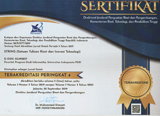Evaluasi Ekonomi dari Produksi Nanopartikel Magnesium Oksida melalui Metode sol-gel Combustion
(1) Universitas Pendidikan Indonesia
(2) Universitas Pendidikan Indonesia
(*) Corresponding Author
Abstract
The purpose of this study is to determine the feasibility of the project to make Magnesium Oxide (MgO) sol gel combustion method by evaluating the engineering and economic aspects. Several economic evaluation parameters are analyzed to inform the potential production of MgO nanoparticles, the length of time required for an investment to recover the total initial expenditure (PBP), project conditions for a production in the form of a production function in years (CNPV), project profits and others. The results showed that the production of MgO nanoparticles was very prospective. Technical analysis to produce 1.38 kg of MgO nanoparticles per day shows the total cost of the equipment purchased was USD 91,542.86. PBP analysis shows that investment profitable after more than 3 years. This project can compete with PBP capital market standards because the investment will return in a short time. To ensure the feasibility of the project, the project is estimated from the ideal conditions to the worst cases in production, including labor, sales, raw materials, utilities, and external conditions (e.g. tax).
Keywords
Full Text:
PDFReferences
Alvionita, N., & Astuti, A. (2017). Sintesis Nanopartikel Magnesium Oksida (MgO) dengan Metode Presipitasi. Jurnal Fisika Unand, 6(1), 89-92.
Yuan, G., Zheng, J., Lin, C., Chang, X., & Jiang, H. (2011). Electrosynthesis and catalytic properties of magnesium oxide nanocrystals with porous structures. Materials Chemistry and Physics, 130(1-2), 387-391.
Zhang, K., An, Y., Zhang, L., & Dong, Q. (2012). Preparation of controlled nano-MgO and investigation of its bactericidal properties. Chemosphere, 89(11), 1414-1418.
Mantilaka, M. P. G., De Silva, R. T., Ratnayake, S. P., Amaratunga, G., & de Silva, K. N. (2018). Photocatalytic activity of electrospun MgO nanofibres: synthesis, characterization and applications. Materials Research Bulletin, 99, 204-210.
Mahmoud, H. R., Ibrahim, S. M., & El-Molla, S. A. (2016). Textile dye removal from aqueous solutions using cheap MgO nanomaterials: adsorption kinetics, isotherm studies and thermodynamics. Advanced Powder Technology, 27(1), 223-231.
Stankic, S., Müller, M., Diwald, O., Sterrer, M., Knözinger, E., & Bernardi, J. (2005). Size?dependent optical properties of MgO nanocubes. Angewandte Chemie International Edition, 44(31), 4917-4920.
Umar, A., Rahman, M. M., & Hahn, Y. B. (2009). MgO polyhedral nanocages and nanocrystals based glucose biosensor. Electrochemistry Communications, 11(7), 1353-1357.
Nassar, M. Y., Mohamed, T. Y., Ahmed, I. S., & Samir, I. (2017). MgO nanostructure via a sol-gel combustion synthesis method using different fuels: an efficient nano-adsorbent for the removal of some anionic textile dyes. Journal of Molecular Liquids, 225, 730-740.
Athar, T., Hakeem, A., & Ahmed, W. (2012). Synthesis of MgO nanopowder via non aqueous sol–gel method. Advanced Science Letters, 7(1), 27-29.
Ding, Y., Zhang, G., Wu, H., Hai, B., Wang, L., & Qian, Y. (2001). Nanoscale magnesium hydroxide and magnesium oxide powders: control over size, shape, and structure via hydrothermal synthesis. Chemistry of materials, 13(2), 435-440.
Li, S., Zhou, B., Ren, B., Xing, L., Tan, L., Dong, L., & Li, J. (2016). Preparation of MgO nanomaterials by microemulsion-based oil/water interface precipitation. Materials Letters, 171, 204-207.
Granados-Correa, F., Bonifacio-Martínez, J., Lara, V. H., Bosch, P., & Bulbulian, S. (2008). Cobalt sorption properties of MgO prepared by solution combustion. Applied Surface Science, 254(15), 4688-4694.
Nandiyanto, A. B. D. (2018). Cost analysis and economic evaluation for the fabrication of activated carbon and silica particles from rice straw waste. Journal of Engineering Science and Technology, 13(6), 1523-1539.
Garrett, D. E. (2012). Chemical engineering economics. Springer Science & Business Media.
Bank Indonesia. (2018) “Foreign Exchange Rates”. [Online]. Available: https://www.bi.go.id/en/moneter/informasi-kurs/referensi-jisdor/
Sudaryanto, S., & Agustinus, E. T. S. (2006). TEKNO EKONOMI PRODUKSI GLASIR BERBAHAN BAKU TUFA ANDESITIK PALIMANAN. RISET Geologi dan Pertambangan, 16(1), 9-23.
Nandatamadini, F., Karina, S., & Nandiyanto, A. B. D. FEASIBILITY STUDY BASED ON ECONOMIC PERSPECTIVE OF COBALT NANOPARTICLE SYNTHESIS WITH CHEMICAL REDUCTION METHOD. CAKRA KIMIA (Indonesian E-Journal of Applied Chemistry), 7(1), 61-68
DOI: http://dx.doi.org/10.30998/string.v4i2.5216
Refbacks
- There are currently no refbacks.
Copyright (c) 2019 Dea Bella Dewary Atika, Asep Bayu Nandiyanto

This work is licensed under a Creative Commons Attribution 4.0 International License.
STRING (Satuan Tulisan Riset dan Inovasi Teknologi) indexed by:

Ciptaan disebarluaskan di bawah Lisensi Creative Commons Atribusi 4.0 Internasional.
View My Stats

 Sertifikat Akreditasi
Sertifikat Akreditasi
















